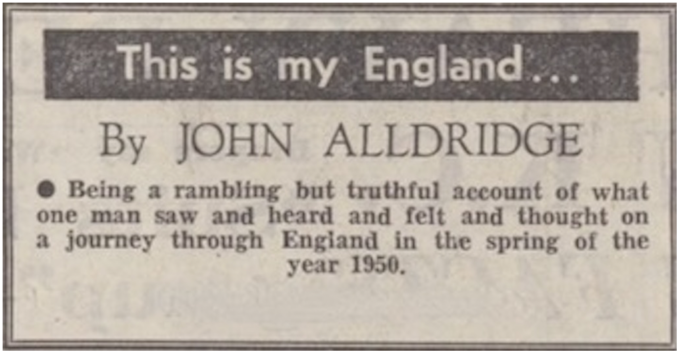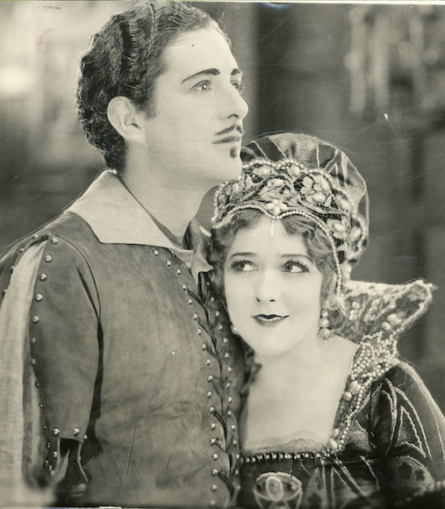
This is my England…,
© 2022 Newspapers.com – Licence CC BY-SA 2.0
Since this journey must begin somewhere, let it begin here in Bakewell with the story of a tart. A Bakewell tart, which, of course — as they are quick to point out — isn’t a tart at all, but a Pudding. The smallest, neatest, most delicious pudding in the world.
I can give that verdict now with authority, having just eaten two of them at a sitting. They came to us straight from the oven, piping hot. Oozing raspberry jam and scented with almonds. Still puffed up with wholly justifiable conceit.
And this is the story of how the jam got into the pudding by mistake. And how that happy mistake founded an industry which — until recently —brought the whiff of an English bake-house to remote places of the earth where Englishmen go out in the noonday sun and pine for the marrow-soddening drizzle of an English spring.
It seems that just short of a century ago they were holding a dinner party at the Rutland Hotel, which is an easy stone’s throw from where we were eating our puddings.
The host, an Italian nobleman in exile, sent down to the kitchen his own recipe for the sweet.
What that original recipe might have been we don’t know. But we do know that what came up from the kitchen that evening was the very first Bakewell pudding.
The bewildered cook, used to dealing with plain, honest Derbyshire stuff, lost her head completely: and, as an inexperienced barman will sometimes mix, out of sheer desperation, an incomparable cocktail, this anonymous heroine rushed frantically into the pantry, grabbed the first jar of jam she saw there, and produced a masterpiece.
That might have been the end of the story had not one of the guests that night been a canny Yorkshirewoman. A Mrs. Wilson, whose husband had lately started up a small tallow-candle factory just outside the town.
This Mrs. Joseph Wilson was a born businesswoman. Before that evening was over she had been down to the kitchen, interviewed the terrified cook, bought from her the secret of the wonderful new delicacy, and taken her into partnership.
And before the end of that week the first batch of Bakewell puddings were being sold from her own dripping pan in her own prim Victorian house.
And before the year was out Mr. Wilson had sold his candle factory, bought up the confectioner’s shop next door, and founded a thriving family industry which has raised this placid little country town to the world status of Eccles and Bath and Chelsea.
Nowadays you can buy so-called mass-produced Bakewell tarts in any teashop. But by comparison these are poor things: as much like the real thing as cooking sherry resembles amontillado.
For the real thing you must come to this little grey cake shop with the mullioned windows and the quiet air of always having belonged in Quality-street, where the puddings are prepared in the same whitewashed bakehouse where they were first tried and tested in 1865. (For Government controls make it impossible to sell them across the counter.)
And if you are lucky you may meet Mr. Alfred Rose, a patriarch among pastry cooks, who first learned the trick of making them 75 years ago.
And if you think this is just a pleasant little local legend it will probably surprise you to learn that when the present owner of the property — Mrs. Rebecca Needham, another shrewd businesswoman — bought the goodwill from the Wilson family a few years ago she had to pay £8,800 in hard cash for the secret recipe.
I have seen that recipe — or, rather, I have seen the original penny notebook in which it was written in shaky, smudged pencil, among a mouth-watering anthology of suggestions for bride cake and drop scones.
Night and day it remains where it is safe from profane hands — in a steel-lined fire-proof safe.
They gave us lunch in Bakewell — a delightful lunch, built around slices of home-cured ham and a garden salad. But after those Bakewell puddings we had no appetite left.
We toyed with it politely and pushed on up the road to Haddon Hall. And if you want to see what an Englishman’s castle really looks like you should pay your two shillings and let the past and a pleasant knowledgeable — but not too knowledgeable — guide take over. Looking around Haddon Hall you begin to understand why Britain remained an island for so long. For one thing they had a perfect passion, these rugged individualists, for locking doors behind them.
They even had special gates with criss-cross bars to keep the dogs — and there must have been dozens of dogs — out of the dining room.
Once inside his castle walls, those formidable double doors locked behind him, your Tudor lord had nothing to fear but his conscience. And I doubt whether that bothered him much.

Haddon Hall – Bakewell, Derbyshire, England.,
Daderot – Public domain
When George Vernon began to rebuild Haddon in 1517 almost the first thing he did was to have carved over the main gate, under his twelve quarterings, the family motto, “God save the Vernon.” It was more a command than a pious request.
You can see them at dinnertime, Sir George and the Lady Margaret, his wife, sitting up there at the high table under the wonderful floral tapestry with its royal coat-of-arms which Henry VIII presented to his father to pay off a long-standing debt.
Below him — well below the symbolical platter of salt — sit his retainers, nearly a hundred of them, each according to his station.
For a man knew his place in those days. And kept to it if he knew what was good for him.
When that unknown Elizabethan glazier received his eightpence for “mendynge of ye glass in divers places of the house” he knew better than to go complaining to his shop steward.
And what days those were for eating and drinking! Look at that enormous hoop — so big that a medium-sized whale could swim through it with ease — from some gigantic beer cask which hangs under the arch of the North-west Entrance Tower; walk through those kitchens, which surely were built for some pantomime giant, not a simple English baron.
The place still reeks of oxen roasted whole, of gigantic chines and sides of beef. There is a butcher’s block here as big as a double bed: a wooden carving table, with an ingenious hole bored through it for draining off the gravy.
That hole is so big that nowadays it would swallow up the meat ration, gravy and all, of a family of five, if you took your eyes off it for a second.
No matter where you walk in this place you can’t get away from visions of gargantuan banquets. The very crests and coats-of-arms are lavishly decorated with the life-size heads of boars and bulls and peacocks.
Even in the exquisite fifteenth-century chapel, dedicated to St. Nicholas (who, after all, suggests an endless surfeit of Christmas dinners), there’s a wall painting showing the good Saint in the act of restoring to life three little boys who had allowed themselves to be cut up and pickled.
It was in the banqueting hall that our amiable, painstaking guide unwittingly destroyed one of my fondest illusions. Ever since, as a ten-year-old, I sneaked into the local cinema to see a dimpled Mary Pickford, as Dorothy Vernon, eloping from a Californian Haddon Hall twice as large and three times as natural as the original, I have cherished the memory of Dorothy escaping from that crowded ballroom at midnight to meet her lover, John Manners, waiting for her, horses ready saddled, at the narrow stone footbridge over the Wye and riding with him through the night to be married at Aylestone Church.

Dorothy Vernon of Haddon Hall,
Unknown photographer – Public domain
Now they tell me that it never happened that way: that they probably never eloped at all: that the famous ballroom was not even built until John and Dorothy had been many years married.
But for all that I shall remain faithful to the legend. I want to go on thinking of Dorothy slipping out of that old iron-studded door, which they have called after her, and standing for a long moment while the moonlight gilded the roses in the silent rose garden.
But, of course, that couldn’t have happened either. Because this perfect little garden was not laid out and planted until 1928.
And there we met the man whose patient skill and loving care have made this rose garden the lovely thing it is.
It is sad but inevitable, I suppose, that gardeners like Bert Hibbitt belong to a dying race. If it were otherwise there would be a dozen eager young gardeners clamouring to take his place.
For Bert is well on in his sixties: and his only assistant is a man older even than himself.
Bert Hibbitt started the hard way as apprentice to a market gardener in Oakham (he is, incidentally the only man I have ever met who came from the smallest county in England).
Now, forty years later, he is doing what he likes best, tending his Mrs Samuel Macreadys and his Golden Glories, taking a quiet pride that up here on these few inches of poor soil his roses are invariably in bloom a full six weeks ahead of most gardens.
It has something to do with the limestone walls that shelter his garden.
“Limestone has a way of holding in the heat of the sun,” he explains.
But if he will forgive me – for he is a modest man – I suggest it has a lot more to do with Bert Hibbitt.
Sometimes a wealthy American tourist, watching Bert pruning his rose trees or mowing his splendid acre of Cumberland turf, will try and persuade him to come to America and work the same miracle in Kansas City or Cedar Rapids.
But, “I don’t bother much about that kind of talk,” says Bert diffidently, smoothing his grizzled moustache. Perhaps nowhere else in the world would he be so free as he is here among his roses.
When you hear Bert Hibbitt refer, quite naturally, to his beloved “Caroline Testout” as a “she” you understand, for the first time, what Wordsworth was trying to express when he wrote those much-abused lines:
“And ’tis my faith that every flower
Enjoys the air it breathes…”
Reproduced with permission
© 20223 Newspapers.com
Jerry F 2023



